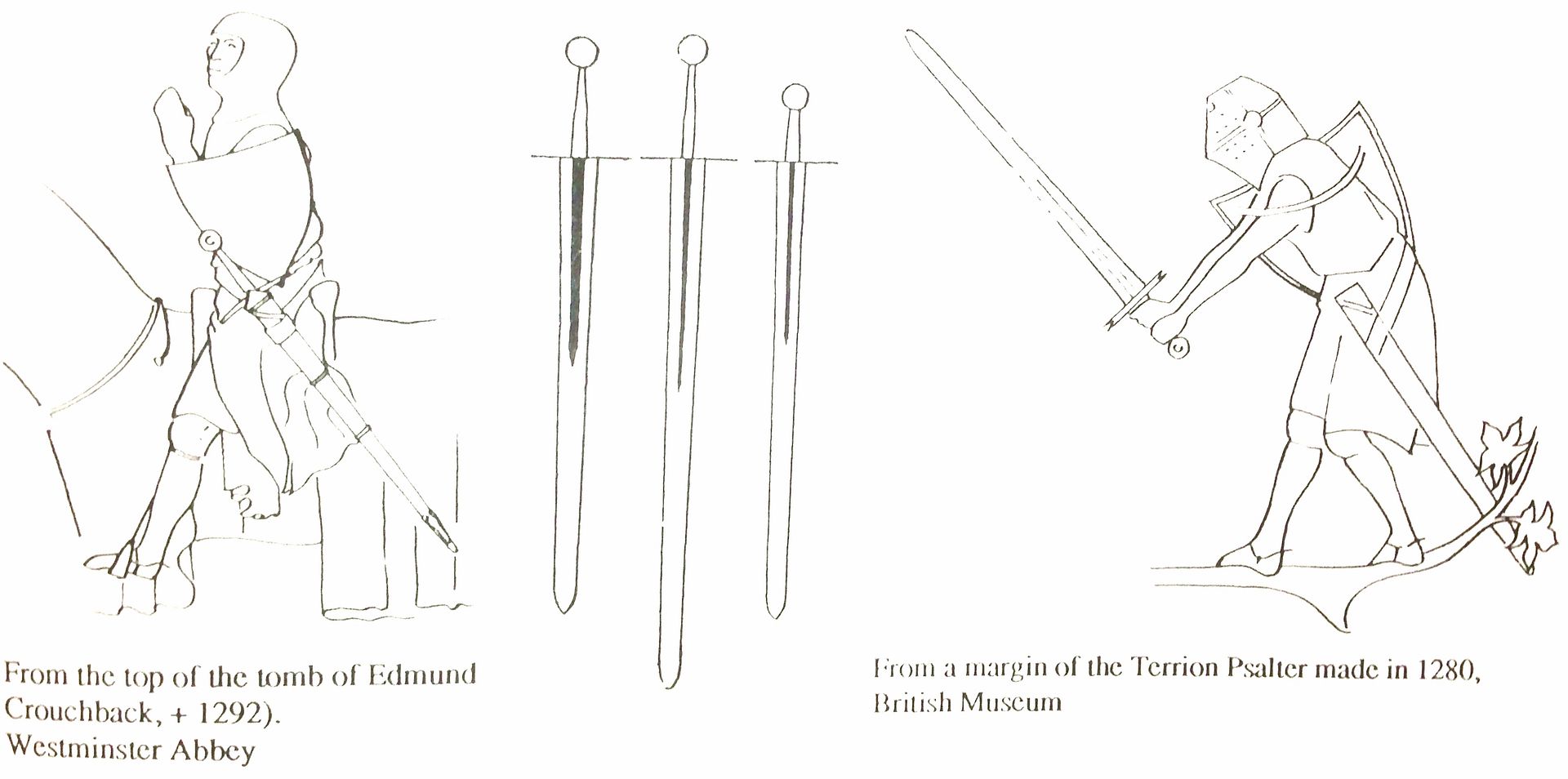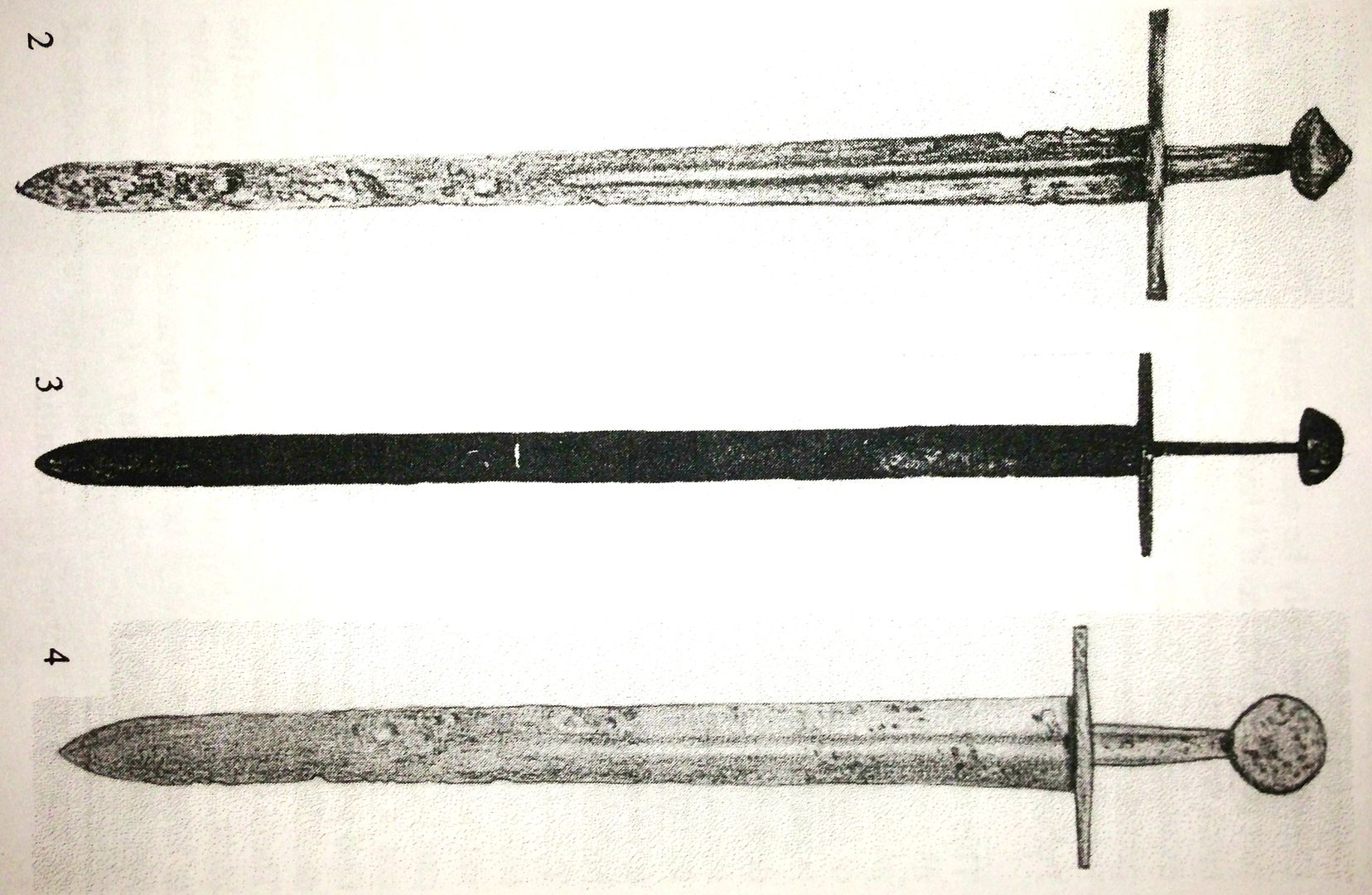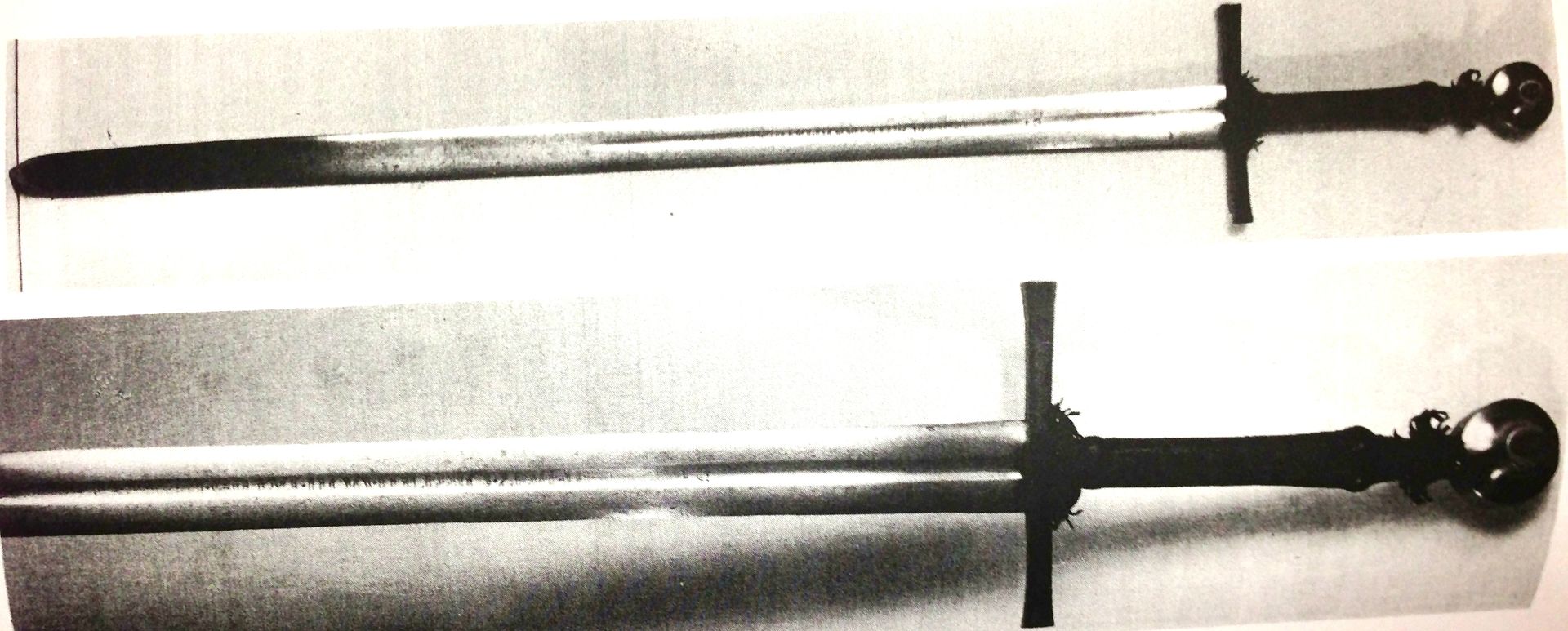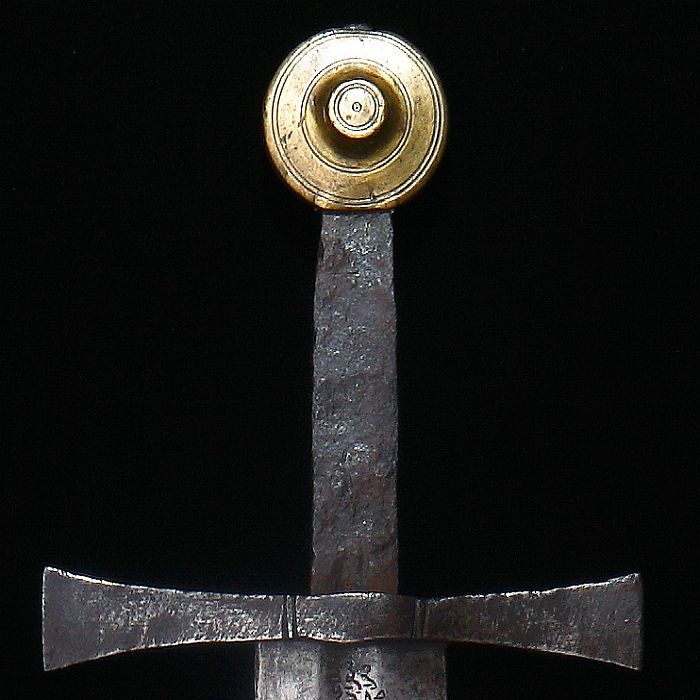Oakeshott Type XIII - XIIIb - Records of the Medieval Sword
Jul 9, 2013 11:56:55 GMT
Post by Jack Loomes on Jul 9, 2013 11:56:55 GMT
Link to Sword-Site's Collection of Original Historic Type XIII - XIIIb Swords here: sword-site.com/board/24/oakeshott-type-xiii-xiiib-swords
Extract from Records of the Medieval Sword by Ewart Oakeshott
Characteristic of this type (whose sub-type contains the majority fo suriving examples) is a blade whose edges run very nearly parallel to a rounded point, and whose tang is noticeably longer than the usual 3"-4" (8.2cms or 11.1cms) of single-hand sword of the preceding types. The sub-type, XIIIa, is the 'Grete War Sword' par excellence with its very large blade 32"-40" (81.cms or 11.cms) average length and long grip, of between 6" and 10" (15cms and 25.5cms). Pommel forms on survivors vary, though the 'wheel' shape of pommel-types I to K predominate. Crosses both on surviving examples and shown in art are nearly always straight, generally of Style 2.
The are often mentioned in inventory, poem and chronicle as 'Swerdes of Werre', 'Grans Espees d'Allemagne', 'Schlachtschwerte', 'Grete Swords', Espees de Guerre'. 'Grete War Swords' and son on, always indicating large size and specific purpose. German tomb effigies of the 14th century; they are found nearly as often upon Spanish effigies of the same period, and occasionally on English ones. There are so few French knight tomb effigies left since the destructive efforts of the Revolutionaries of 1789 that it is not possible to quote a single French example. The very fact, I believe, that the French in the 13th and 14th centuries always referred to them as 'big German swords' is proof enough that Germany was their area of origin and greatest use.
Those shown in art are generally dateable between say c.1250 and 1370; the German and Spanish effigies between 1320-1370. There is, however, archaeological evidence to suggest very strongly that these big, hand-and-a-half gripped swords were not uncommon as early as the 12th century. (See Appendix B).
The XIIIa's vary greatly in size, some being true two-hand swords. A prime example of such an outsize one is the sword of Edward III in St George's Chapel in Windsor Castle, which has been there since the Order of the Garter - or at least, St George's Chapel - was founded in the mid-14th century. This sword is overall more than six feet long, yet its proportions are such that it must be classified as an XIIIa. By contrast, a more modest one is shown here at XIIIa.2 though it is still a very big sword.
I know of a few good examples of Type XIII, all shown here, One of the best (XIII.1) used to be in the Harold Peterson Collection in Virginia; a second is in the Royal Armouries (shown here in Multiple Miscellaneous 1 below) a third in the Royal Scottish Museum in Edinburgh, and a fourth, a very big sword with an enormously broad blade, which I saw, and drew at Sotheby's in the days of my youth, in 1935. There is a fifth in a private collection in Italy. These are shown below.
Sub-type XIIIb has been isolated, though its variation from Type XIII itself is so slight that much isolation seems to be splitting hairs; but I have made it so, therefore I am committed to allowing it to stand. The only real difference from Type XIII is that the grip is shorter; the form of the blade remains the same.

XIII. 1
Type: XIII
Find-place: Unknown
Collection: Ex Harold Peterson, ex D'Acre Edwards, now private
Blade-length: 31" (78.7cms)
Pommel-type: J
Cross-style: 2
Date: ?1200-1300
Condition: Excavated (?river-found?). Excellent. Very little pitting. When I saw it at the D'Acre Edwards sale in 1960, it had a curiously greenish patination. Since it was sold at Harold Peterson's sale at Christies on July 5th, 1978, I have lost track of it.
This is an absolutely classic example of a Type XIII sword with its parallel-edged blade blade, rounded point and long grip. The three fullers in blade are rather uncommon. but by no means unusual in swords dating from the fourth century to the 18th. There is a mark on the blade which I noted in 1960, but unfortunately cannot now find to include here! The sword handles well, but as may be expected of a slashing-sword, the point of balance is well down toward the point. Its weight is just over 3lbs.

XIII. 2- 4
2. Type: XIII
Find-place: Unknown
Collection: Royal Scottish Museum, Edinburgh
Blade-length: 31&1/2 (80cms)
Pommel-type: E
Cross-style: 2
Date: c.1250 + or - 20
Condition: Excavated. River? Good. Some pitting.
Publication: J.G. Scott. European Arms & Armour at Kelvin-grove. (Glasgow, 1980.)
3. Type: XIII
Find-Place: Unknown
Collection: Unkown
Blade-length: 32 (81.2cms)
Pommel-type: G
Cross-style: 1
Date: c.1200-50 (the hilt form suggest a century earlier)
Condition: Excavated. River. Good. Some pitting, quite deep.
4. Type: XIII
Fin-place: Unknown
Collection: Private
Blade-length: 33" (83.8cms)
Pommel-type: B.1
Cross-style:1
Date: c.1150-1200
Condition: Excavated. River. Good
These three Type XIII swords are shown together, to a constant scale, to show the great size of No.4. This I saw, handled, and drew at Sotheby's in 1935. It isn't as heavy as it looks, but it is quite remarkable in the breadth of its blade, and the diameter of its flat, thin pommel to match. I did not noted any marks.
No.2 in Edinburg is a less handsome sword; if it wasn't for the nearly parallel edges of this blade, it would have to be categorised as Type XII, not a XIII, especially as the grip is short. There is a tiny inlaid three-letter inscription - O S O - in silver, There is no parallel for this among Leppaaho's grave-finds though it is a common enough inscription, sometimes written SOS on XIIth century blades. The pommel is very massive, being very broad in profile. Rather a clumsy sword.
No.3 is a classic XIII, interestingly for its purely VIking form of pommel and its very thin, stalk like tang. Tangs like this are not very common, though by no means rare. They look, seen fac-one, as if they were thin and weak in contrast to the very broad flat tangs more often seen. However, the section of these stalk-like tangs is square; there is a as much solid metal as in the broad, flat ones.

XIIIa. 1
Type: XIIIa
ind-place: Unkown to me
Collection: Kunsthistorisches Museum, Vienna. Wien A8W
Blade-length: 40" approximately (101.2cms)
Pommel-type: J in an extremely deep form
Cross-style: 2
Date: c. 1300-50
Condition: Can only be called 'mint'. The blade bears no rust-pits and looks as if it had never been used. Pommel and cros are unstained - not, I think, overcleaned - but the small escutcheon of ?silver or enamel in the central bossof the pommel is missing. The grip, (with its circular tassles top and bottom of cut leather is an early 16rh century refurbishment.
Publication: Gamber, p.22. no. 17.
This is perhaps the supreme examples of a Type XIIIa sword, its perfect preservation indicates its centuries-long sojourn, probably unused, in an armory. It is known ' The Sword of Dietrich von Bern'. This name has been given in Germanic legend to the Ostrogth 5th century Emperor Theodoric, Thidrek in the Volsungsaga, and in the Nibelgenlied. The sword must, I think, date in the first half of the 14th century for (a) it is so typical of those big 'Risenschwerte' which are to be so clearly seen on tomb effigies of this period and (b) because the very distinctively-shaped 'wheel' pommel of Type J in an exaggerate form doesn't seem to have been used before c. 1300: but this can only be said with a strong reservation. I don't know of an example, actual or pictured, which can be positively said to predate 1300. That, however, does not at all mean or even suggest, that some day we shall not find proof that such a pommel-form was in fact in use many decades earlier. I can only present what is known now.
There is a beautifully executed inscription in the fuller of the blade. This does not seem to be etched, nor is it inlaid in silver or latten; it just seems to be lightly engraved, and was added, like the grip, in the 16th cnetury. It reads Gennant Herr Dietrich vons Berns Schwere, the letters being characteristic of the time of Exmperor Maximillian 1.

XIIIb. 4
Type: XIII. b
Find-place: Alexandria, Arsenal
Collection: Philadelphia Art Museum (Kienbusch Collection)
Blade-length: 34&1/2 (87.6cms)
Pommel-type: An exaggerate Type K
Cross-style: 5
Date: c.1350-60
Condition: Very good. Indoor preservation, the grip lost. The pommel is of latten. The inscription on the blade, in Arabic Nashki script tells that it was deposited in the Hall of Victories in 1367 (A.H. 769). This suggests that it might be spoil from an abortive atack upon Cairo in 1365 by Pierre de Lusignan, titular King of Jersualem, based in Cyprus. However, like so many of these European deposited in the Mamlik arsenal at Alexandria, it may have been simply a gift. There is a whole grip of these swords, of this precise type and form; nine of them are now in Askeri Museum at Istanbul, one is in the Royal Ontario Museum in Toronto, and one came up for sale at Christie' in March 1988.
Publication: Oakeshott, SAX, Plate 12A; Alexander, D.G. 'European Swords in the COllection at Istanbul' ZHWK, 1985. (This deals with nine in Istanbul); Blair, C. EAA 29.



Oakeshott Sword Type X: sword-site.com/thread/118/oakeshott-type-records-medieval-sword
Oakeshott Sword Type Xa: sword-site.com/thread/123/oakeshott-type-records-medieval-sword
Oakeshott Sword Type XI - XIa: sword-site.com/thread/126/oakeshott-type-records-medieval-sword
Oakeshott Sword Type XII: sword-site.com/thread/127/oakeshott-type-records-medieval-sword
Oakeshott Sword Type XIIa: sword-site.com/thread/128/oakeshott-type-records-medieval-sword
Oakeshott Sword Type XIII - XIIIb: sword-site.com/thread/152/oakeshott-xiiib-records-medieval-sword
Oakeshott Sword Type XIV: sword-site.com/thread/159/oakeshott-type-records-medieval-sword
Oakeshott Sword Type XV - XVa: sword-site.com/thread/166/oakeshott-type-records-medieval-sword
Oakeshott Sword Type XVI - XVIa: sword-site.com/thread/167/oakeshott-type-records-medieval-sword
Oakeshott Sword Type XVII: sword-site.com/thread/175/oakeshott-type-records-medieval-sword
Oakeshott Sword Type XVIII - XVIIIa: sword-site.com/thread/183/oakeshott-xviii-xviiia-records-medieval
Oakeshott Sword Type XIX: sword-site.com/thread/187/oakeshott-type-records-medieval-sword
Oakeshott Sword Type XX - XXa: sword-site.com/thread/200/oakeshott-type-records-medieval-sword
Oakeshott Sword Type XXI - XXII: sword-site.com/thread/204/oakeshott-type-records-medieval-sword
Diagram of Oakeshott's Sword Types: sword-site.com/thread/251/index-ewart-oakeshotts-medieval-typologies
Extract from Records of the Medieval Sword by Ewart Oakeshott
Characteristic of this type (whose sub-type contains the majority fo suriving examples) is a blade whose edges run very nearly parallel to a rounded point, and whose tang is noticeably longer than the usual 3"-4" (8.2cms or 11.1cms) of single-hand sword of the preceding types. The sub-type, XIIIa, is the 'Grete War Sword' par excellence with its very large blade 32"-40" (81.cms or 11.cms) average length and long grip, of between 6" and 10" (15cms and 25.5cms). Pommel forms on survivors vary, though the 'wheel' shape of pommel-types I to K predominate. Crosses both on surviving examples and shown in art are nearly always straight, generally of Style 2.
The are often mentioned in inventory, poem and chronicle as 'Swerdes of Werre', 'Grans Espees d'Allemagne', 'Schlachtschwerte', 'Grete Swords', Espees de Guerre'. 'Grete War Swords' and son on, always indicating large size and specific purpose. German tomb effigies of the 14th century; they are found nearly as often upon Spanish effigies of the same period, and occasionally on English ones. There are so few French knight tomb effigies left since the destructive efforts of the Revolutionaries of 1789 that it is not possible to quote a single French example. The very fact, I believe, that the French in the 13th and 14th centuries always referred to them as 'big German swords' is proof enough that Germany was their area of origin and greatest use.
Those shown in art are generally dateable between say c.1250 and 1370; the German and Spanish effigies between 1320-1370. There is, however, archaeological evidence to suggest very strongly that these big, hand-and-a-half gripped swords were not uncommon as early as the 12th century. (See Appendix B).
The XIIIa's vary greatly in size, some being true two-hand swords. A prime example of such an outsize one is the sword of Edward III in St George's Chapel in Windsor Castle, which has been there since the Order of the Garter - or at least, St George's Chapel - was founded in the mid-14th century. This sword is overall more than six feet long, yet its proportions are such that it must be classified as an XIIIa. By contrast, a more modest one is shown here at XIIIa.2 though it is still a very big sword.
I know of a few good examples of Type XIII, all shown here, One of the best (XIII.1) used to be in the Harold Peterson Collection in Virginia; a second is in the Royal Armouries (shown here in Multiple Miscellaneous 1 below) a third in the Royal Scottish Museum in Edinburgh, and a fourth, a very big sword with an enormously broad blade, which I saw, and drew at Sotheby's in the days of my youth, in 1935. There is a fifth in a private collection in Italy. These are shown below.
Sub-type XIIIb has been isolated, though its variation from Type XIII itself is so slight that much isolation seems to be splitting hairs; but I have made it so, therefore I am committed to allowing it to stand. The only real difference from Type XIII is that the grip is shorter; the form of the blade remains the same.

XIII. 1
Type: XIII
Find-place: Unknown
Collection: Ex Harold Peterson, ex D'Acre Edwards, now private
Blade-length: 31" (78.7cms)
Pommel-type: J
Cross-style: 2
Date: ?1200-1300
Condition: Excavated (?river-found?). Excellent. Very little pitting. When I saw it at the D'Acre Edwards sale in 1960, it had a curiously greenish patination. Since it was sold at Harold Peterson's sale at Christies on July 5th, 1978, I have lost track of it.
This is an absolutely classic example of a Type XIII sword with its parallel-edged blade blade, rounded point and long grip. The three fullers in blade are rather uncommon. but by no means unusual in swords dating from the fourth century to the 18th. There is a mark on the blade which I noted in 1960, but unfortunately cannot now find to include here! The sword handles well, but as may be expected of a slashing-sword, the point of balance is well down toward the point. Its weight is just over 3lbs.

XIII. 2- 4
2. Type: XIII
Find-place: Unknown
Collection: Royal Scottish Museum, Edinburgh
Blade-length: 31&1/2 (80cms)
Pommel-type: E
Cross-style: 2
Date: c.1250 + or - 20
Condition: Excavated. River? Good. Some pitting.
Publication: J.G. Scott. European Arms & Armour at Kelvin-grove. (Glasgow, 1980.)
3. Type: XIII
Find-Place: Unknown
Collection: Unkown
Blade-length: 32 (81.2cms)
Pommel-type: G
Cross-style: 1
Date: c.1200-50 (the hilt form suggest a century earlier)
Condition: Excavated. River. Good. Some pitting, quite deep.
4. Type: XIII
Fin-place: Unknown
Collection: Private
Blade-length: 33" (83.8cms)
Pommel-type: B.1
Cross-style:1
Date: c.1150-1200
Condition: Excavated. River. Good
These three Type XIII swords are shown together, to a constant scale, to show the great size of No.4. This I saw, handled, and drew at Sotheby's in 1935. It isn't as heavy as it looks, but it is quite remarkable in the breadth of its blade, and the diameter of its flat, thin pommel to match. I did not noted any marks.
No.2 in Edinburg is a less handsome sword; if it wasn't for the nearly parallel edges of this blade, it would have to be categorised as Type XII, not a XIII, especially as the grip is short. There is a tiny inlaid three-letter inscription - O S O - in silver, There is no parallel for this among Leppaaho's grave-finds though it is a common enough inscription, sometimes written SOS on XIIth century blades. The pommel is very massive, being very broad in profile. Rather a clumsy sword.
No.3 is a classic XIII, interestingly for its purely VIking form of pommel and its very thin, stalk like tang. Tangs like this are not very common, though by no means rare. They look, seen fac-one, as if they were thin and weak in contrast to the very broad flat tangs more often seen. However, the section of these stalk-like tangs is square; there is a as much solid metal as in the broad, flat ones.

XIIIa. 1
Type: XIIIa
ind-place: Unkown to me
Collection: Kunsthistorisches Museum, Vienna. Wien A8W
Blade-length: 40" approximately (101.2cms)
Pommel-type: J in an extremely deep form
Cross-style: 2
Date: c. 1300-50
Condition: Can only be called 'mint'. The blade bears no rust-pits and looks as if it had never been used. Pommel and cros are unstained - not, I think, overcleaned - but the small escutcheon of ?silver or enamel in the central bossof the pommel is missing. The grip, (with its circular tassles top and bottom of cut leather is an early 16rh century refurbishment.
Publication: Gamber, p.22. no. 17.
This is perhaps the supreme examples of a Type XIIIa sword, its perfect preservation indicates its centuries-long sojourn, probably unused, in an armory. It is known ' The Sword of Dietrich von Bern'. This name has been given in Germanic legend to the Ostrogth 5th century Emperor Theodoric, Thidrek in the Volsungsaga, and in the Nibelgenlied. The sword must, I think, date in the first half of the 14th century for (a) it is so typical of those big 'Risenschwerte' which are to be so clearly seen on tomb effigies of this period and (b) because the very distinctively-shaped 'wheel' pommel of Type J in an exaggerate form doesn't seem to have been used before c. 1300: but this can only be said with a strong reservation. I don't know of an example, actual or pictured, which can be positively said to predate 1300. That, however, does not at all mean or even suggest, that some day we shall not find proof that such a pommel-form was in fact in use many decades earlier. I can only present what is known now.
There is a beautifully executed inscription in the fuller of the blade. This does not seem to be etched, nor is it inlaid in silver or latten; it just seems to be lightly engraved, and was added, like the grip, in the 16th cnetury. It reads Gennant Herr Dietrich vons Berns Schwere, the letters being characteristic of the time of Exmperor Maximillian 1.

XIIIb. 4
Type: XIII. b
Find-place: Alexandria, Arsenal
Collection: Philadelphia Art Museum (Kienbusch Collection)
Blade-length: 34&1/2 (87.6cms)
Pommel-type: An exaggerate Type K
Cross-style: 5
Date: c.1350-60
Condition: Very good. Indoor preservation, the grip lost. The pommel is of latten. The inscription on the blade, in Arabic Nashki script tells that it was deposited in the Hall of Victories in 1367 (A.H. 769). This suggests that it might be spoil from an abortive atack upon Cairo in 1365 by Pierre de Lusignan, titular King of Jersualem, based in Cyprus. However, like so many of these European deposited in the Mamlik arsenal at Alexandria, it may have been simply a gift. There is a whole grip of these swords, of this precise type and form; nine of them are now in Askeri Museum at Istanbul, one is in the Royal Ontario Museum in Toronto, and one came up for sale at Christie' in March 1988.
Publication: Oakeshott, SAX, Plate 12A; Alexander, D.G. 'European Swords in the COllection at Istanbul' ZHWK, 1985. (This deals with nine in Istanbul); Blair, C. EAA 29.



Oakeshott Sword Type X: sword-site.com/thread/118/oakeshott-type-records-medieval-sword
Oakeshott Sword Type Xa: sword-site.com/thread/123/oakeshott-type-records-medieval-sword
Oakeshott Sword Type XI - XIa: sword-site.com/thread/126/oakeshott-type-records-medieval-sword
Oakeshott Sword Type XII: sword-site.com/thread/127/oakeshott-type-records-medieval-sword
Oakeshott Sword Type XIIa: sword-site.com/thread/128/oakeshott-type-records-medieval-sword
Oakeshott Sword Type XIII - XIIIb: sword-site.com/thread/152/oakeshott-xiiib-records-medieval-sword
Oakeshott Sword Type XIV: sword-site.com/thread/159/oakeshott-type-records-medieval-sword
Oakeshott Sword Type XV - XVa: sword-site.com/thread/166/oakeshott-type-records-medieval-sword
Oakeshott Sword Type XVI - XVIa: sword-site.com/thread/167/oakeshott-type-records-medieval-sword
Oakeshott Sword Type XVII: sword-site.com/thread/175/oakeshott-type-records-medieval-sword
Oakeshott Sword Type XVIII - XVIIIa: sword-site.com/thread/183/oakeshott-xviii-xviiia-records-medieval
Oakeshott Sword Type XIX: sword-site.com/thread/187/oakeshott-type-records-medieval-sword
Oakeshott Sword Type XX - XXa: sword-site.com/thread/200/oakeshott-type-records-medieval-sword
Oakeshott Sword Type XXI - XXII: sword-site.com/thread/204/oakeshott-type-records-medieval-sword
Diagram of Oakeshott's Sword Types: sword-site.com/thread/251/index-ewart-oakeshotts-medieval-typologies

.png?width=1920&height=1080&fit=bounds)